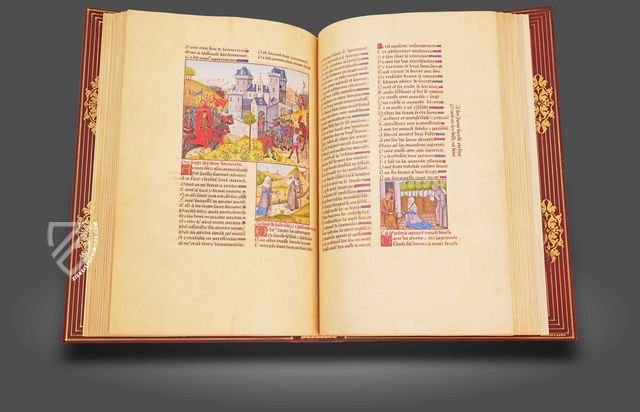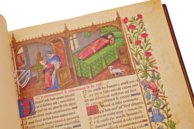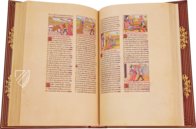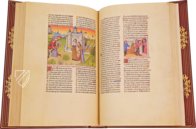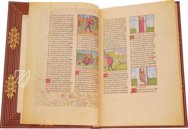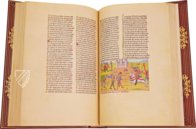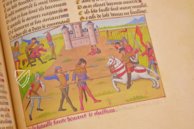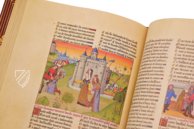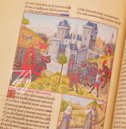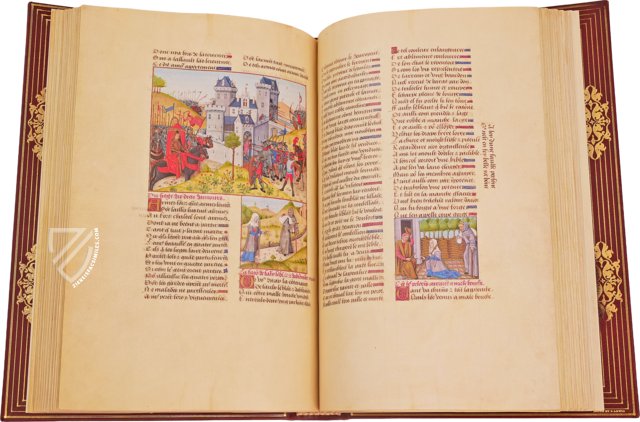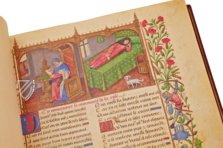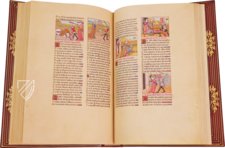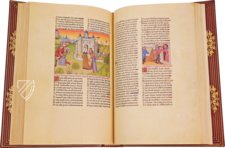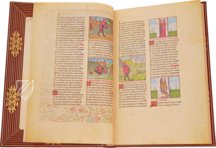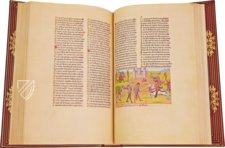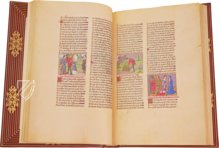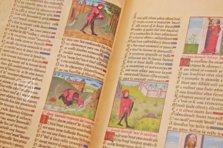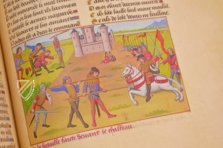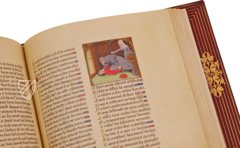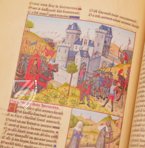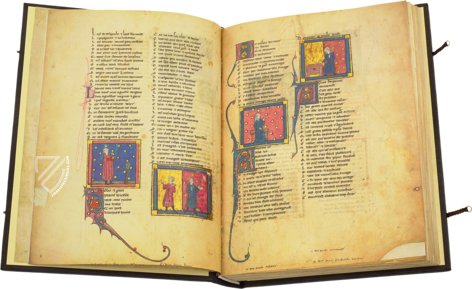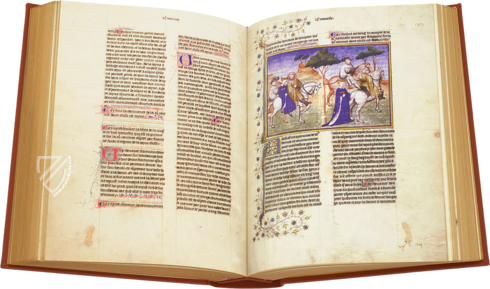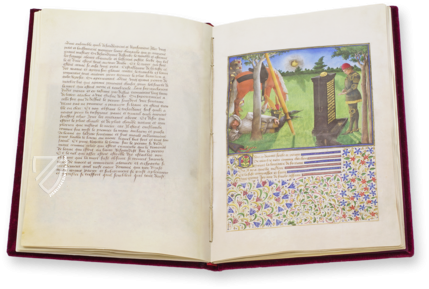Douce Roman de la Rose
The Douce Roman de la Rose in the Bodlein Library is one of the richest illuminated manuscripts of the medieval bestseller. It was commissioned by Louise of Savoy (1476–1531), who at the time of its creation was still Countess of Angoulême, and was decorated by Robinet Testard (fl. 1475–1531) with a total of 127 expressive, narrative miniatures and dozens of golden decorated initials. The Romance of the Rose, begun by Guillaume de Lorris around 1235 and completed by Jean de Meung in Paris around 1280, was one of the most widely read works in France until the Renaissance. It was not only the use of the first-person perspective that was groundbreaking, but also the allegorical figures and the presentation of the entire narration in the form of a dream. At the same time, however, the Old French work was already highly controversial in the 13th century: while some were disturbed by the uncommonly sensual language and erotic motifs, others criticized the misogyny it manifested – among them for example Christine de Pizan (1364–1429).
Douce Roman de la Rose
This influential Old French verse novel uses numerous allegories to tell the story of a long dream. The dreamer appears as the protagonist and first-person narrator and, in the course of his dream, falls in love with a beautiful rose, whose affection he ultimately wins. However, to do so, he must overcome numerous obstacles, many of which are emotional in nature. The rose serves as an allegory for the woman who is to be won. She therefore plays a rather passive role, while being protected by the allegories of her feelings – such as resistance, shame, and fear. The protagonist, on the other hand, is supported by the allegories of courtesy and frankness, for example.
A Revolution in Medieval Literature
With these completely new narrative techniques, the Romance of the Rose shook the medieval literary scene and is still considered a masterpiece of stylistic innovation that influenced writers for centuries. It was the first French novel written from the perspective of a first-person narrator and also the first novel written entirely in the form of a dream account. Equally new was the use of allegorical figures as acting characters in the novel. In fact, with the exception of the narrator, all the characters are imaginary figures who either originate from mythology – for example, Amor – or are allegories. In this way, the Romance of the Roserevolutionized medieval literature.
A Masterpiece by Two Authors
Two authors were responsible for this groundbreaking work: Guillaume de Lorris (c. 1200–c. 1240) and Jean de Meung (c. 1240–c. 1305). Guillaume began the verse novel around 1235, but interrupted his work at verse 1068. It is possible that the author died before he could complete the text. However, somewhere in the middle of the narrative, he had the loving protagonist remark that he would explain the deeper meaning of the work later. Above all, he had hinted that he would obtain the rose at the end of a long battle. Apparently, these remarks gave the writer Jean de Meung the idea of a sequel which he wrote between 1275 and 1280.
Not surprisingly, the two parts differ greatly from each other, even though they belong together in terms of content. While the first part by Guillaume de Lorris is entirely in the tradition of courtly love poetry of his time, Jean de Meung, as a townsman, wrote from an ironic distance to the courtly mindset of his predecessor. Overall, he represents rational and skeptical, almost materialistic ideas.
Magnificent Illumination for a Royal Patron
The Romance of the Rose in the Bodleian Library in Oxford is without question one of the most beautiful and luxurious manuscripts of the literary bestseller. It was illuminated by none other than Robinet Testard (fl. 1470–1531) with 127 beautiful and detailed miniatures, most of which were inserted into the text columns, but some of which are half-page in size. The beautiful codex was created between 1487 and 1496 for Louise of Savoy (1476–1531), the mother of the French king Francis I (1494–1547) and later regent of France. Her coat of arms is prominently displayed on the first page of the novel, which is also the only one surrounded by an fanciful border. Remarkably, a manuscript of the Romance of the Rose belonging to Francis I has also been preserved – it seems that literary taste was passed down in the family.
Codicology
- Alternative Titles
- Il manoscritto Douce 195
Roman de la Rose - Ms. Douce 195
Romance of the Rose
Rosenroman - Size / Format
- 312 pages / 34.2 × 23.5 cm
- Origin
- France
- Date
- Between 1487 and 1496
- Epochs
- Style
- Genre
- Language
- Script
- French littera bastarda
- Illustrations
- 7 large and 120 column-wide miniatures, numerous decorated initials
- Content
- Romance of the Rose by Guillaume de Lorris and Jean de Meun
- Patron
- Louise of Savoy (1476–1531)
- Artist / School
- Robinet Testard (illuminator)
- Previous Owners
- Justin MacCarthy-Reagh
George Hibbert
Francis Douce
Douce Roman de la Rose
The Battle for the Rose
In this large allegorical miniature, Amor's troops attack the labyrinthine and well-protected castle of the Rose, which the protagonist is trying to win. They are led by Amor's barons False Appearance, Abstinence, Courtesy, and Frankness. Meanwhile, at the behest of Lady Suspicion, the castle is defended to the last by the personifications of Resistance, Shame, Fear, and Evil Tongue. The scene is an allegory of the obstacles that the lover must overcome in order to win his beloved. The miniature is an artistic representation providing fascinating information about contemporary fashion, armor, weapons, and architecture.

Douce Roman de la Rose
The Dream Begins
The first page of the manuscript combines opulent illumination with references to the author and the patron. A floral border with several animal and human drolleries encloses the beginning of the verse novel. It begins with a blue initial “M” displaying the joined coats of arms of the Houses of Orléans and Savoy in its interior field – the heraldic symbol of Louise of Savoy (1476–1531) after her marriage.
Above the text are two small miniatures in a coherent frame of delicate Gothic architectural elements. The author's portrait on the left shows Guillaume de Lorris working on his best-selling novel – under the watchful gaze of two curious bystanders. The miniature on the right is the visual introduction to the story: Aman, the first-person narrator and protagonist, lies fully clothed on his bed of precious textiles, having fallen asleep with a scroll in his hand. The empty chair invites the reader to join him and follow his dream, but is guarded by his loyal dog.
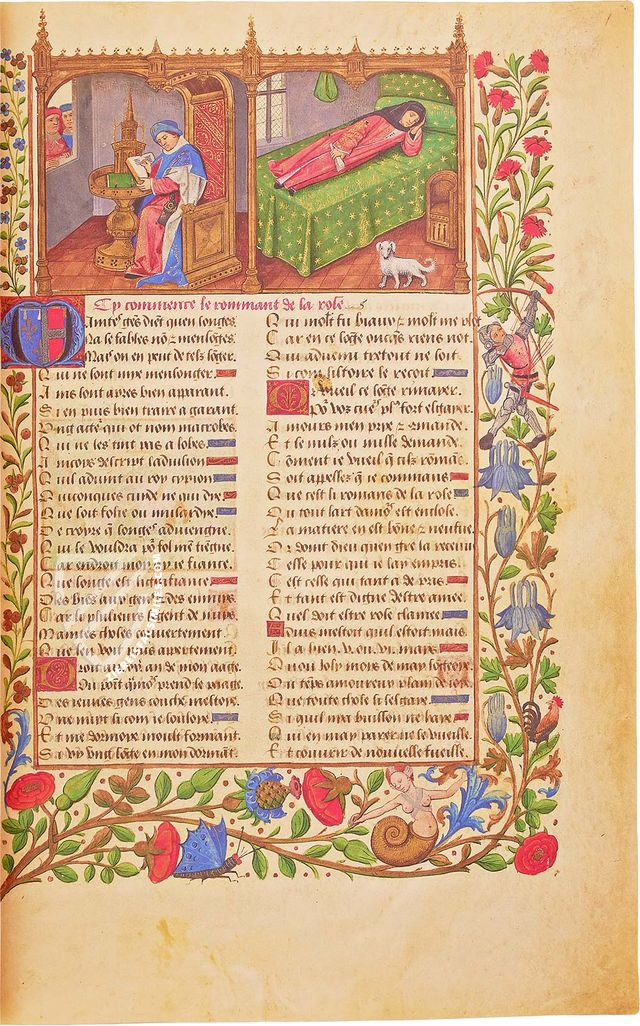
#1 Il manoscritto Douce 195
Language: Italian
- Treatises / Secular Books
- Apocalypses / Beatus
- Astronomy / Astrology
- Bestiaries
- Bibles / Gospels
- Chronicles / History / Law
- Geography / Maps
- Saints' Lives
- Islam / Oriental
- Judaism / Hebrew
- Single Leaf Collections
- Leonardo da Vinci
- Literature / Poetry
- Liturgical Manuscripts
- Medicine / Botany / Alchemy
- Music
- Mythology / Prophecies
- Psalters
- Other Religious Books
- Games / Hunting
- Private Devotion Books
- Other Genres
- Afghanistan
- Armenia
- Austria
- Belgium
- Belize
- Bosnia and Herzegovina
- China
- Colombia
- Costa Rica
- Croatia
- Cyprus
- Czech Republic
- Denmark
- Egypt
- El Salvador
- Ethiopia
- France
- Germany
- Greece
- Guatemala
- Honduras
- Hungary
- India
- Iran
- Iraq
- Israel
- Italy
- Japan
- Jordan
- Kazakhstan
- Kyrgyzstan
- Lebanon
- Liechtenstein
- Luxembourg
- Mexico
- Morocco
- Netherlands
- Palestine
- Panama
- Peru
- Poland
- Portugal
- Romania
- Russia
- Serbia
- Spain
- Sri Lanka
- Sweden
- Switzerland
- Syria
- Tajikistan
- Turkey
- Turkmenistan
- Ukraine
- United Kingdom
- United States
- Uzbekistan
- Vatican City
- A. Oosthoek, van Holkema & Warendorf
- Aboca Museum
- Ajuntament de Valencia
- Akademie Verlag
- Akademische Druck- u. Verlagsanstalt (ADEVA)
- Aldo Ausilio Editore - Bottega d’Erasmo
- Alecto Historical Editions
- Alkuin Verlag
- Almqvist & Wiksell
- Amilcare Pizzi
- Andreas & Andreas Verlagsbuchhandlung
- Archa 90
- Archiv Verlag
- Archivi Edizioni
- Arnold Verlag
- ARS
- Ars Magna
- ArtCodex
- AyN Ediciones
- Azimuth Editions
- Badenia Verlag
- Bärenreiter-Verlag
- Belser Verlag
- Belser Verlag / WK Wertkontor
- Benziger Verlag
- Bernardinum Wydawnictwo
- BiblioGemma
- Biblioteca Apostolica Vaticana (Vaticanstadt, Vaticanstadt)
- Bibliotheca Palatina Faksimile Verlag
- Bibliotheca Rara
- Boydell & Brewer
- Bramante Edizioni
- Bredius Genootschap
- Brepols Publishers
- British Library
- C. Weckesser
- Caixa Catalunya
- Canesi
- CAPSA, Ars Scriptoria
- Caratzas Brothers, Publishers
- Carus Verlag
- Casamassima Libri
- Centrum Cartographie Verlag GmbH
- Chavane Verlag
- Christian Brandstätter Verlag
- Circulo Cientifico
- Club Bibliófilo Versol
- Club du Livre
- CM Editores
- Collegium Graphicum
- Collezione Apocrifa Da Vinci
- Comissão Nacional para as Comemorações dos Descobrimentos Portugueses
- Coron Verlag
- Corvina
- CTHS
- D. S. Brewer
- Damon
- De Agostini/UTET
- De Nederlandsche Boekhandel
- De Schutter
- Deuschle & Stemmle
- Deutscher Verlag für Kunstwissenschaft
- DIAMM
- Droz
- E. Schreiber Graphische Kunstanstalten
- Ediciones Boreal
- Ediciones Grial
- Ediclube
- Edições Inapa
- Edilan
- Editalia
- Edition Deuschle
- Edition Georg Popp
- Edition Leipzig
- Edition Libri Illustri
- Editiones Reales Sitios S. L.
- Éditions de l'Oiseau Lyre
- Editions Medicina Rara
- Editorial Casariego
- Editorial Mintzoa
- Editrice Antenore
- Editrice Velar
- Edizioni Edison
- Egeria, S.L.
- Eikon Editores
- Electa
- Emery Walker Limited
- Enciclopèdia Catalana
- Eos-Verlag
- Ephesus Publishing
- Ernst Battenberg
- Eugrammia Press
- Extraordinary Editions
- Fackelverlag
- Facsimila Art & Edition
- Facsimile Editions Ltd.
- Facsimilia Art & Edition Ebert KG
- Faksimile Verlag
- Feuermann Verlag
- Folger Shakespeare Library
- Franco Cosimo Panini Editore
- Friedrich Wittig Verlag
- Fundación Hullera Vasco-Leonesa
- G. Braziller
- Gabriele Mazzotta Editore
- Gebr. Mann Verlag
- Gesellschaft für graphische Industrie
- Getty Research Institute
- Giovanni Domenico de Rossi
- Giunti Editore
- Graffiti
- Grafica European Center of Fine Arts
- Guido Pressler
- Guillermo Blazquez
- Gustav Kiepenheuer
- H. N. Abrams
- Harrassowitz
- Harvard University Press
- Helikon
- Hendrickson Publishers
- Henning Oppermann
- Herder Verlag
- Hes & De Graaf Publishers
- Hoepli
- Holbein-Verlag
- Houghton Library
- Hugo Schmidt Verlag
- Idion Verlag
- Il Bulino, edizioni d'arte
- ILte
- Imago
- Insel Verlag
- Insel-Verlag Anton Kippenberger
- Instituto de Estudios Altoaragoneses
- Instituto Nacional de Antropología e Historia
- Istituto dell'Enciclopedia Italiana - Treccani
- Istituto Ellenico di Studi Bizantini e Postbizantini
- Istituto Geografico De Agostini
- Istituto Poligrafico e Zecca dello Stato
- Italarte Art Establishments
- Jan Thorbecke Verlag
- Johnson Reprint Corporation
- Josef Stocker
- Josef Stocker-Schmid
- Jugoslavija
- Karl W. Hiersemann
- Kasper Straube
- Kaydeda Ediciones
- Kindler Verlag / Coron Verlag
- Kodansha International Ltd.
- Konrad Kölbl Verlag
- Kurt Wolff Verlag
- La Liberia dello Stato
- La Linea Editrice
- La Meta Editore
- Lambert Schneider
- Landeskreditbank Baden-Württemberg
- Leo S. Olschki
- Les Incunables
- Liber Artis
- Library of Congress
- Libreria Musicale Italiana
- Lichtdruck
- Lito Immagine Editore
- Lumen Artis
- Lund Humphries
- M. Moleiro Editor
- Maison des Sciences de l'homme et de la société de Poitiers
- Manuscriptum
- Martinus Nijhoff
- Maruzen-Yushodo Co. Ltd.
- MASA
- Massada Publishers
- McGraw-Hill
- Metropolitan Museum of Art
- Militos
- Millennium Liber
- Müller & Schindler
- Nahar - Stavit
- Nahar and Steimatzky
- National Library of Wales
- Neri Pozza
- Nova Charta
- Oceanum Verlag
- Odeon
- Orbis Mediaevalis
- Orbis Pictus
- Österreichische Staatsdruckerei
- Oxford University Press
- Pageant Books
- Parzellers Buchverlag
- Patrimonio Ediciones
- Pattloch Verlag
- PIAF
- Pieper Verlag
- Plon-Nourrit et cie
- Poligrafiche Bolis
- Presses Universitaires de Strasbourg
- Prestel Verlag
- Princeton University Press
- Prisma Verlag
- Priuli & Verlucca, editori
- Pro Sport Verlag
- Propyläen Verlag
- Pytheas Books
- Quaternio Verlag Luzern
- Reales Sitios
- Recht-Verlag
- Reichert Verlag
- Reichsdruckerei
- Reprint Verlag
- Riehn & Reusch
- Roberto Vattori Editore
- Rosenkilde and Bagger
- Roxburghe Club
- Salerno Editrice
- Saltellus Press
- Sandoz
- Sarajevo Svjetlost
- Schöck ArtPrint Kft.
- Schulsinger Brothers
- Scolar Press
- Scrinium
- Scripta Maneant
- Scriptorium
- Shazar
- Siloé, arte y bibliofilia
- SISMEL - Edizioni del Galluzzo
- Sociedad Mexicana de Antropología
- Société des Bibliophiles & Iconophiles de Belgique
- Soncin Publishing
- Sorli Ediciones
- Stainer and Bell
- Studer
- Styria Verlag
- Sumptibus Pragopress
- Szegedi Tudomànyegyetem
- Taberna Libraria
- Tarshish Books
- Taschen
- Tempus Libri
- Testimonio Compañía Editorial
- Thames and Hudson
- The Clear Vue Publishing Partnership Limited
- The Facsimile Codex
- The Folio Society
- The Marquess of Normanby
- The Richard III and Yorkist History Trust
- Tip.Le.Co
- TouchArt
- TREC Publishing House
- TRI Publishing Co.
- Trident Editore
- Tuliba Collection
- Typis Regiae Officinae Polygraphicae
- Union Verlag Berlin
- Universidad de Granada
- University of California Press
- University of Chicago Press
- Urs Graf
- Vallecchi
- Van Wijnen
- VCH, Acta Humaniora
- VDI Verlag
- VEB Deutscher Verlag für Musik
- Verlag Anton Pustet / Andreas Verlag
- Verlag Bibliophile Drucke Josef Stocker
- Verlag der Münchner Drucke
- Verlag für Regionalgeschichte
- Verlag Styria
- Vicent Garcia Editores
- W. Turnowski Ltd.
- W. Turnowsky
- Waanders Printers
- Wiener Mechitharisten-Congregation (Wien, Österreich)
- Wissenschaftliche Buchgesellschaft
- Wissenschaftliche Verlagsgesellschaft
- Wydawnictwo Dolnoslaskie
- Xuntanza Editorial
- Zakład Narodowy
- Zollikofer AG

